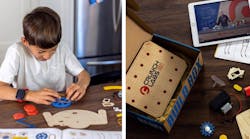Happy Holidays: Wacky DIY Project Kits Develop Creativity and Problem-Solving Skills
Check out more galleries and articles in Holiday Gifts for Engineers of All Ages.
This gallery appeared in Electronic Design and has been published here with permission.
I dare you to watch CrunchLabs' video about its Build Box project kits and not crack a smile. Unlike so many "educational" STEM toys, this series of "fun-forward" DIY games and projects stealthily introduce important problem-solving skills without giving off even a hint of "good-for-you" vibes that might spoil the fun. Although I haven't laid hands on a Build Box (yet), I'm pretty sure it will be a hit for both nerds and non-nerds alike.
The Build Box kits are offered as a monthly subscription series (2, 4, 6, or 12 kits @$24.95-$29.95/month), with each kit containing an original, buildable engineering toy and a highly entertaining (and science-packed) video. Mark Rober, CrunchLabs' self-appointed Head Nerd & former NASA engineer, describes these kits as part of a massive, Willy Wonka-style factory of creativity that helps kids (and kids at heart) develop their creative powers and "learn to think like an engineer."
CrunchLabs Build Boxes are designed for kids ages 8-12+, but they appear to be clever enough that adults will actually enjoy playing alongside their kids. I wish these had been around when I was a kid, but look forward to sharing them with several nieces and nephews.
To order, or learn more, visit https://www.crunchlabs.com/.
More Geek Fun
If you’re looking for another present for the budding genius in your life, consider the Spintronics learning lab that won last year's Geek Gift of the Year award. It combines hands-on experiments with mechanical analogs of electrical components, plus a graphic novel and an engaging online role-playing game.

